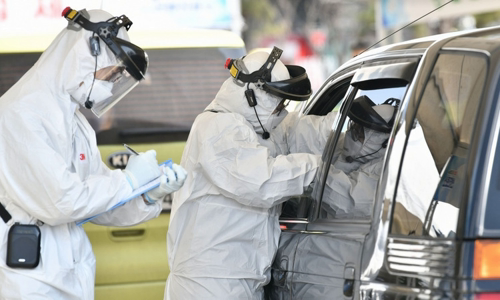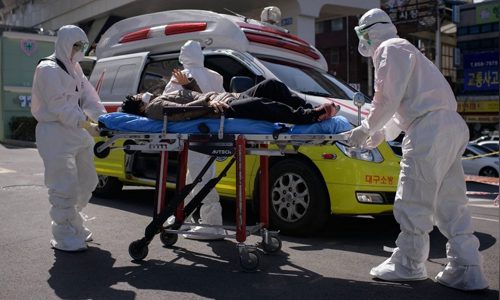A large-scale testing program and efforts to isolate nCoV-infected people help South Korea control its Covid-19 infection.
Europe is the global Covid-19 center, with the number of new infections constantly increasing in countries such as Italy, Spain, Germany and France. Many countries must apply measures to blockade and close the border to prevent nCoV from spreading. Meanwhile, the US is also at risk of "breaking the battle" when the test suites fail and there is no specific plan to deal with Covid-19.

Medical staff at a mobile testing station north of Seoul Photo: AFP
In this context, Korea is considered a sign of hope and also a model for many countries to study. The country of 50 million people seems to be curbing the spread of Covid-19 when only 93 new nCoV infections were recorded on March 17, compared with 909 on February 29, the peak period of the epidemic. sick.
South Korea does this without taking tough measures like blocking a city. "We feel it is an unreasonable option," said Kim Woo-joo, an infectious disease expert at Korea University, and warned that the disease could flare up again even if the number of New cases are declining.
South Korea's success stems from its extensive and well-organized testing program, combined with efforts to quarantine nCoV cases and find people who have had contact with patients.
"Extensive diagnostic capabilities are the key to disease control. Discovering journeys and contacts is also highly influential," said Raina MacIntyre, a scholar at the University of New South Wales in Sydney.
South Korea has tested more than 270,000 people to date, reaching 5,200 tests per million people, more than any country except Bahrain. The number in the US is 74 tests per million people, according to the US Centers for Disease Control and Prevention (CDC).
However, this success may not last long. New cases are declining as Seoul completes a cluster investigation at Tan Thien Dia denominational church in Daegu city, where more than 5,000 positive cases have been recorded, accounting for 60% of all new infections in South Korea. .
"That keeps us from investigating other areas," said Oh Myoung-don, an epidemiologist at Korea National University.
New phrases have begun to appear. Officials have recorded 129 new cases, mostly related to a customer care center in southwestern Seoul. "This could be the starting point of spread among the community in Seoul and Gyeonggi Province, where 23 million residents," Kim said.
South Korea understands the importance of disease prevention after a bitter lesson with the Middle East Respiratory Syndrome (MERS). A man returned home after traveling to three Middle Eastern countries and treated at three medical facilities before being diagnosed with MERS and quarantined. By this time, 186 people had been infected, of which 36 died.
The process of screening, tracing the contacts and quarantining nearly 17,000 people helped stop the epidemic after two months, but the epidemic has adversely affected the Korean economy and worried the whole country.
"This fact shows that laboratory testing is an important factor in the control of emerging infectious diseases. Experience from the MERS epidemic helps us improve the control system and prevention of infectious diseases in the muscles." health facilities, "Kim said, adding that no doctor had Covid-19.
The passed laws then allow the government to collect cell phone data, credit cards and various personal information of people who are virus-positive to track their journey. The identity of the infected person is removed before the information is shared on social networks, allowing people to determine whether they have ever been in contact with the patient.

A patient was taken to a hospital in Daegu on March 12 Photo: AFP
Shortly after Covid-19 appeared in China, the Korean Centers for Disease Control and Prevention (KCDC) rushed to develop test kits and collaborate with manufacturers to manufacture commercial products. . The first test kit was licensed on February 7 and distributed to major medical centers, when South Korea detected only a few cases of nCoV.
"Patient 31" was tested positive on February 18. South Korea detected 2,900 new infections in the next 12 days, most of whom were Tan Thien Dia. By February 29, the country became the world's second largest outbreak, trailing only China with more than 3,100 people infected.
The sudden increase in speed overwhelmed the testing capacity, while 130 KCDC detectives were unable to keep up the spread from "patient 31". The journey tracking effort was focused on the epidemic cluster in Daegu, where 80% of people with respiratory symptoms were confirmed to be positive for nCoV, compared to 10% at other locations.
Patients who are at high risk and who have multiple underlying conditions are prioritized for hospitalization, while those with mild symptoms are referred to field areas. They receive basic treatment and supervision until they recover and can return home after two tests for negative results.
In close contact, patients with few symptoms are required to isolate themselves for 2 weeks and to constantly monitor body temperature. A local monitoring team will contact them twice daily to monitor the situation, making sure the quarantine officer does not leave the residence. Those who intentionally evacuate will be fined 2,500 USD. The proposed law earlier this month raised the fine to more than $ 8,200 or one year in prison.
Despite their efforts, Daegu City and North Gyeongsang Province still ran out of treatment for seriously ill people. 4 people isolated themselves at home while waiting for a hospital bed for complications and had to go to emergency, but still died afterwards.
The number of new infections is declining as a result of efforts to keep "social gaps" across the country. The government recommends that people wear masks, constantly wash their hands, avoid crowded people, work remotely and perform religious services online, instead of going to churches. People with fever or breathing problems are urged to stay home to follow for 3-4 days.
"Everyone was shocked by the Tan Thien Dia epidemic. It is now under control," said Chun Byung-Chul, an epidemiologist at Korea University. However, many new clusters are emerging and 20% of positive cases have not been identified as sources of infection, indicating that the risk of community infection has not been determined.
The Korean government hopes to control new epidemic groups soon, similar to how they deal with the Tan Thien Dia epidemic. South Korea can conduct 15,000 tests a day, while 43 mobile sampling points have been deployed across the country. Mobile testing models are being studied by the US, Canada and the UK.
The South Korean Ministry of the Interior last week also announced the application to track isolated people and collect symptom data on suspected cases. However, Chun said researchers still need more data to build disease patterns, as well as the risks from new infections to enhance Covid-19.
Some experts believe that the model may be successful in South Korea, but it is difficult to bring the same effect in the US. Many US states are replicating mobile testing, but the system is unevenly distributed and was only implemented after Covid-19 had spread across major cities.
"As long as this is not certain, it is difficult to say that Korea has passed the epidemic peak," Chun added.



 BelanMartinez
BelanMartinez







